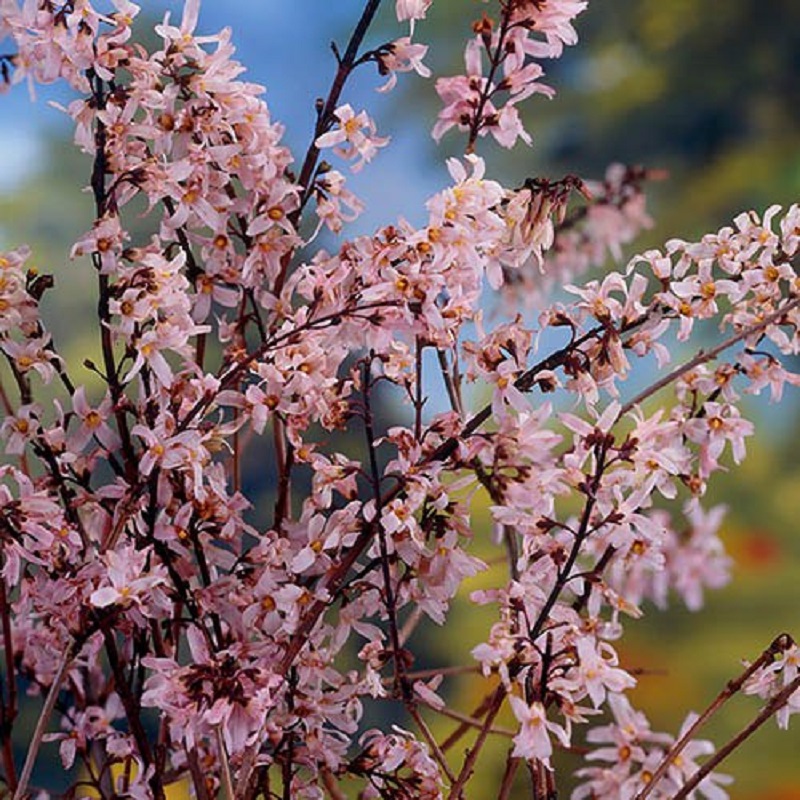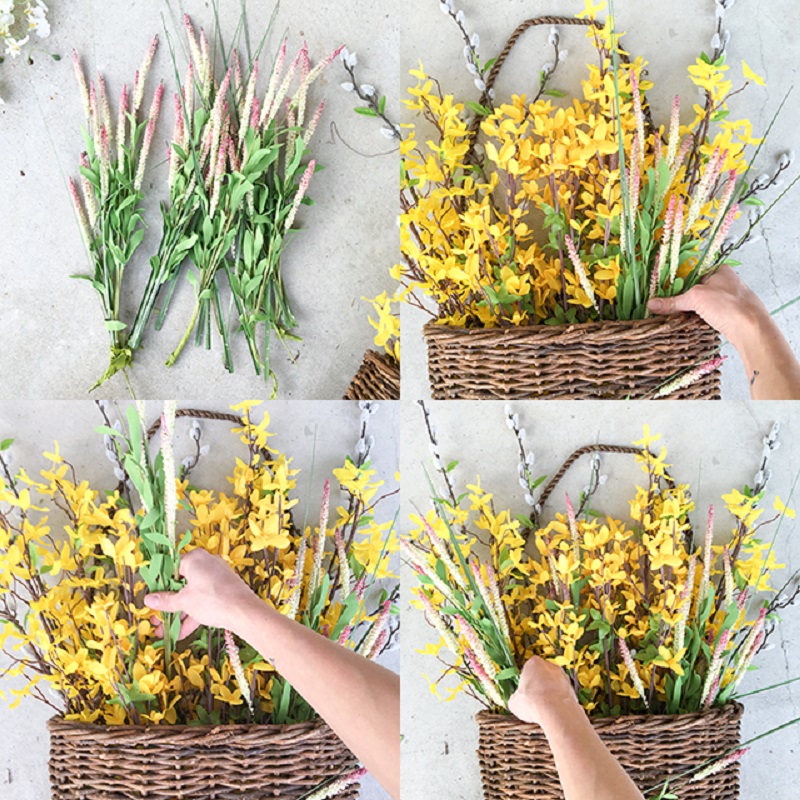Forsythienstrauch - Pflege und Trimmen der Forsythienpflanze Lernen
Die Forsythie ist eine Pflanze aus der Familie der Oleaceae. Der Strauch stammt ursprünglich aus Asien, aber dank seiner Beliebtheit und Anpassungsfähigkeit ist er fast überall auf der Welt verbreitet. Interessanterweise gibt es 8 Arten von Forsythien. Ist Ihnen eine davon ins Auge gefallen, und Sie möchten sie in Ihrem Garten haben? Das ist möglich. Aber prüfen Sie zunächst ihre Bedürfnisse und erfahren Sie, was Sie über die Pflege der Forsythie wissen sollten.

Forsythie - was für eine Pflanze ist das und wie sieht sie aus?
Die Forsythie ist ein sehr beliebter Strauch. Ursprünglich stammt er aus Asien, aber dank seiner Anpassungsfähigkeit kann er überall auf der Welt gepflanzt werden.
Der Strauch blüht im zeitigen Frühjahr und entwickelt kleine gelbe Blüten. Eine blühende Forsythie ist eine wunderschöne Pflanze. Interessanterweise trägt der Strauch keine Blätter, sondern nur Blüten - das ist das charakteristische Merkmal. Das liegt daran, dass die Forsythie früher blüht, als ihre Blätter wachsen können.

Wann blüht die Forsythie?
Die Forsythie blüht im zeitigen Frühjahr. Vieles hängt von den Witterungsbedingungen und Temperaturen ab, die die Entwicklung der Blüten beeinflussen. Alle Zweige dieses Zierstrauches werden mit winzigen, meist gelben Blüten bedeckt. Es gibt auch andere Arten dieser Pflanze. Eine rosafarbene Forsythie ist seltener, aber ebenso schön.
Gelbe Forsythienblüten werden oft zu Ostern verwendet. Sie sind eine typische Osterkorb Dekoration.
Forsythia is a sterile plant - the flowers don’t produce pollen, and therefore, don’t attract insects.
Welche Arten von Forsythien gibt es?
Die gelbe Forsythie ist die beliebteste Art. Sie kommt in der Regel in Gärten vor. Die rosa Forsythie ist eine weitere Farbe dieses Strauches - aber sie ist seltener.
Es gibt viele Arten von Forsythien. Am beliebtesten sind Grenzforsythien und Trauerforsythien.
Die folgenden Forsythiensorten sind in verschiedenen Teilen der Welt beliebt:
- Europäische Forsythie
- Japanische Forsythie
- Koreanische Forsythie
- Forsythie ‘Giraldiana’
- Forsythie ‘Lynwood’
- Forsythie ‘Maluch’
- Forsythie “Goldene Zeiten”
- Forsythie “Courtacour”
- Forsythie ‘Spectabilic Variegated’
- Forsythie ‘Scpecrabilis’

Forsythie - gesundheitliche Vorteile
Die Forsythie wird nicht nur wegen ihres attraktiven Aussehens geschätzt. Nur wenige Menschen wissen um ihre zusätzlichen Vorteile. Dieser Strauch ist dank seiner gesundheitsfördernden Eigenschaften sehr wertvoll. Die Blüten sind reich an Rutozid, das den Vitamin-C-Gehalt unterstützt. Beide Stoffe zusammen verbessern das Immunsystem. Außerdem senken die Blüten dieses Strauches den Blutzuckerspiegel und unterstützen die Diurese.
Was ist der beste Boden für Forsythien?
Ob rosa Forsythie oder Trauerforsythie - egal für welche Sorte Sie sich entscheiden, jede Sorte braucht die richtigen Wachstumsbedingungen. Der Strauch wächst am besten in einem leichten und feuchten Boden. Achten Sie auf den richtigen pH-Wert - zwischen 6,8 und 7,7. Ohne die richtigen Bedingungen verwelkt eine Forsythienpflanze, wenn es keinen Niederschlag gibt.

Wie und wann pflanzt man einen Forsythienstrauch?
Genau wie andere Gartensträucher muss die Forsythie richtig gepflanzt werden. Planen Sie die Pflanzung für das zeitige Frühjahr oder den Spätherbst, wenn der Boden feucht ist. Das sind die idealen Bedingungen für Forsythien.
Nachdem Sie den Platz für die Pflanze ausgewählt haben, graben Sie ein ausreichend großes Loch - es sollte mindestens doppelt so groß sein wie der Topf, in dem der Strauch wächst. Auf diese Weise stellen Sie sicher, dass die Wurzeln genügend Platz zum Wachsen haben, was sich auf das Wohlbefinden der Pflanze auswirkt.
Forsythien gießen - wie oft sollte man die Pflanze gießen?
Ein Forsythienstrauch benötigt intensives Gießen - vor allem in der ersten Wachstumsphase. Gießen Sie die Pflanze auch, wenn die Außentemperaturen stark ansteigen.
Wenn der Strauch ausgewachsen ist, brauchen Sie ihn nicht regelmäßig zu gießen. Die Pflanze kommt mit sich selbst zurecht, sofern sie an einem gut gewählten Standort wächst. Einzige Ausnahme sind Dürreperioden - in diesem Fall sollten Sie Ihre Forsythie alle 2-3 Tage gießen. Während dieser Zeit kann die Pflanze kein Wasser aus dem Boden aufnehmen.

Müssen Forsythiensträucher gedüngt werden?
Eine Forsythie muss regelmäßig gedüngt werden. Vieles hängt jedoch von dem Boden ab, in dem der Strauch wächst. Wenn der Boden reich an Mineralien ist, kann auf eine zusätzliche Düngung verzichtet werden, da die Pflanze unter solchen Bedingungen perfekt wächst. In diesem Fall kann man sich für eine 2-3malige Düngung pro Jahr entscheiden.
Wenn der Boden nicht reich an Mineralien ist, bereiten Sie die Stelle vor, an der Sie eine Forsythie pflanzen wollen, und düngen Sie sie dann das ganze Jahr über. Sie können eine spezielle Mischung kaufen oder sie selbst herstellen. Letzteres ist jedoch für Gartenanfänger nicht zu empfehlen.
Forsythie - Beschneiden
Die richtige Pflege der Forsythie ist entscheidend für ihr Wachstum. Man sollte den Strauch nach der Blütezeit zurückschneiden, am besten bevor die Pflanze Blätter bildet. Die beste Zeit für den Rückschnitt eines Forsythienstrauchs in gemäßigten Zonen ist zwischen Ende April und Anfang Mai. Wenn der Boden und die Witterungsbedingungen gut genug sind, kann die Pflanze auch früher blühen. In anderen Fällen kann die Blüte auch später als erwartet einsetzen. Beobachten Sie die Situation und passen Sie sich entsprechend an.
Wie man Forsythien vermehrt
Die Vermehrung von Forsythien ist einfach. Sie können einen Strauch durch bewurzelte Stecklinge vermehren. Wählen Sie Zweige an der Außenseite der Pflanze. Entfernen Sie die Blätter an der Basis.
Graben Sie ein kleines, 10 Zentimeter tiefes Loch in die Erde und setzen Sie den Steckling hinein. Gießen Sie ihn regelmäßig - die Erde muss feucht bleiben, damit der Steckling Wurzeln schlagen kann.

Forsythie - häufige Krankheiten und Schädlinge
Blattflecken sind das häufigste Problem, unter dem eine Forsythienpflanze leiden kann. Kleine braune Flecken erscheinen auf den Blättern. Die runden Flecken trocknen nach einiger Zeit wieder ab. Wenn sie jedoch großflächig sind, trocknen ganze Blätter ein und fallen ab. Wenn Sie dieses Problem bemerken, verwenden Sie ein spezielles Produkt, das Sie in einem Gartenfachgeschäft kaufen können. Es ist wichtig, das Problem zu beseitigen, da es sich auf andere Pflanzen in Ihrem Garten ausbreiten könnte. Wenn das passiert, ist das Problem viel schwieriger zu lösen.
Wo kann man eine Forsythie kaufen?
Eine Forsythie kann in den meisten Gartencentern gekauft werden. Sie ist eine beliebte Pflanze, vor allem vor Ostern. In dieser Zeit kann man sie sogar in Supermärkten finden.
Wie viel kostet eine Forsythienpflanze?
Ein Forsythienstrauch ist nicht die teuerste Pflanze. Ein Setzling kostet etwa 10 Euro. Die Preise variieren je nach Größe und Art des Setzlings sowie nach der Jahreszeit. Unabhängig von der Seltenheit rosafarbener Sorten kosten sie in der Regel genauso viel wie gelbe.

📍 Wann blüht die Forsythie?
Die Forsythie ist ein beliebter Strauch, der häufig in Gärten gepflanzt wird. Die Forsythie wird vor allem mit dem Frühling in Verbindung gebracht. Dann entwickelt die Pflanze viele kleine Blüten.
📍 Wann pflanzt man einen Forsythienstrauch?
Sie können eine Forsythie zwei Mal im Jahr pflanzen. Der frühe Frühling ist die erste geeignete Jahreszeit, der Herbst die zweite. Diese Termine sind nicht willkürlich, sondern dann, wenn der Boden feucht genug ist, so dass die Pflanze den besten Start hat. Wenn Sie eine Forsythie pflanzen, achten Sie darauf, dass das Pflanzloch mindestens doppelt so breit ist wie der Topf, in dem Sie die Pflanze gepflanzt haben.
📍 Wann sollte man Forsythiensträucher beschneiden?
Sie sollten Forsythien regelmäßig zurückschneiden, aber erst, wenn die Pflanzen nicht mehr blühen. Das ist normalerweise Ende April oder Anfang Mai.
📍 Wie schnell wächst eine Forsythie?
Die Forsythie braucht einige Zeit, um im Boden Wurzeln zu schlagen - das dauert in der Regel bis zu drei Jahre. Nach dieser Zeit beginnt sie zu blühen. Der Strauch wird jedes Jahr über ein Dutzend Zentimeter höher.
Empfohlene Artikel




